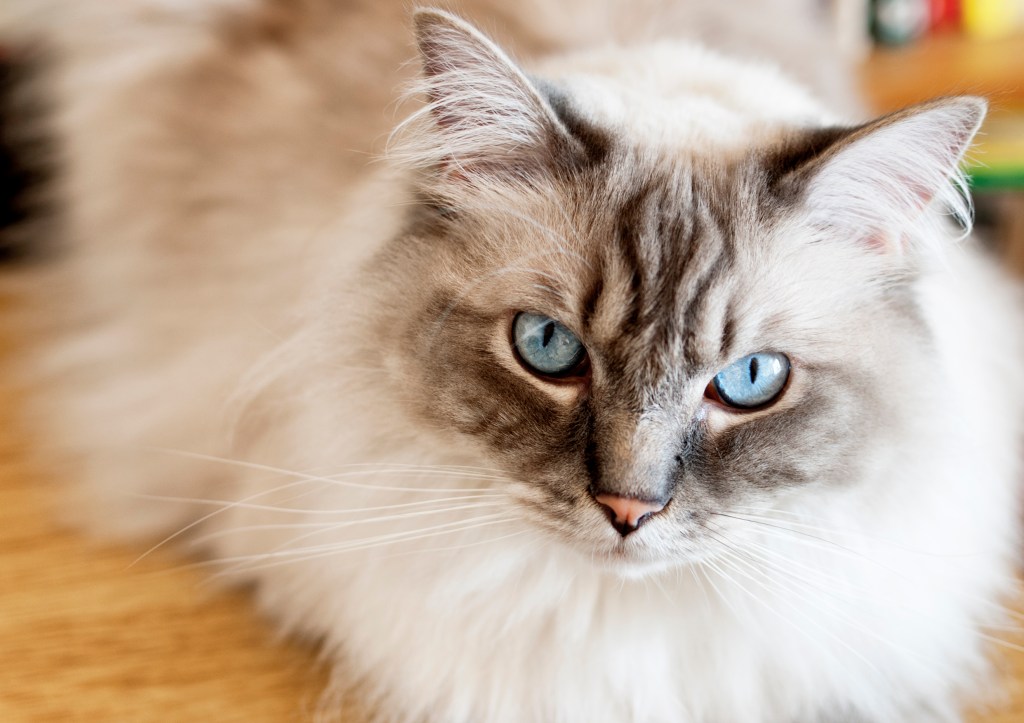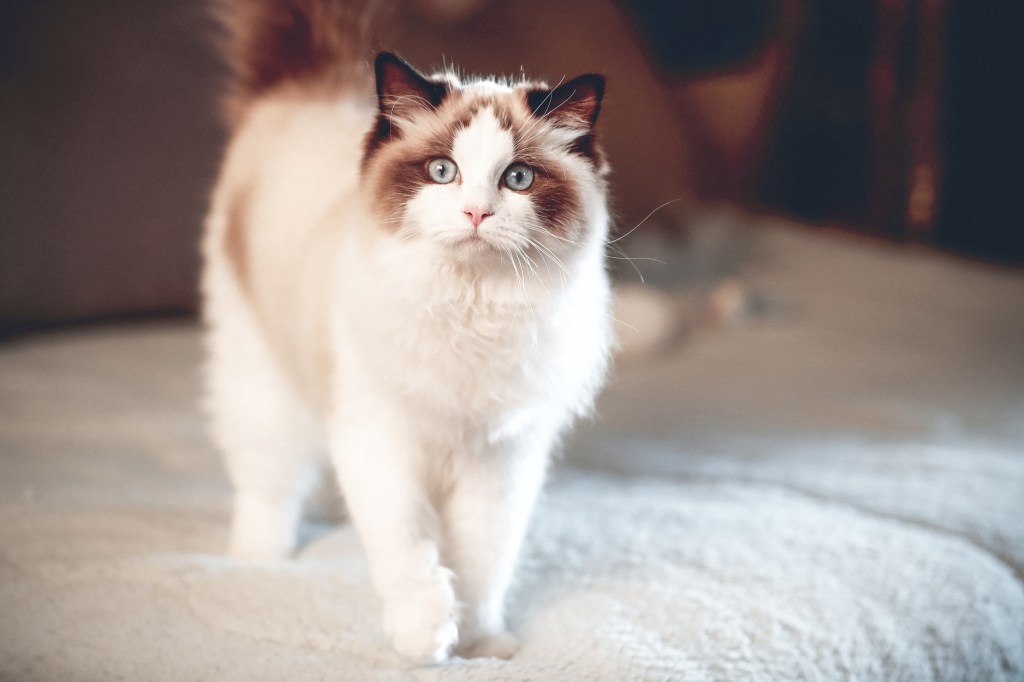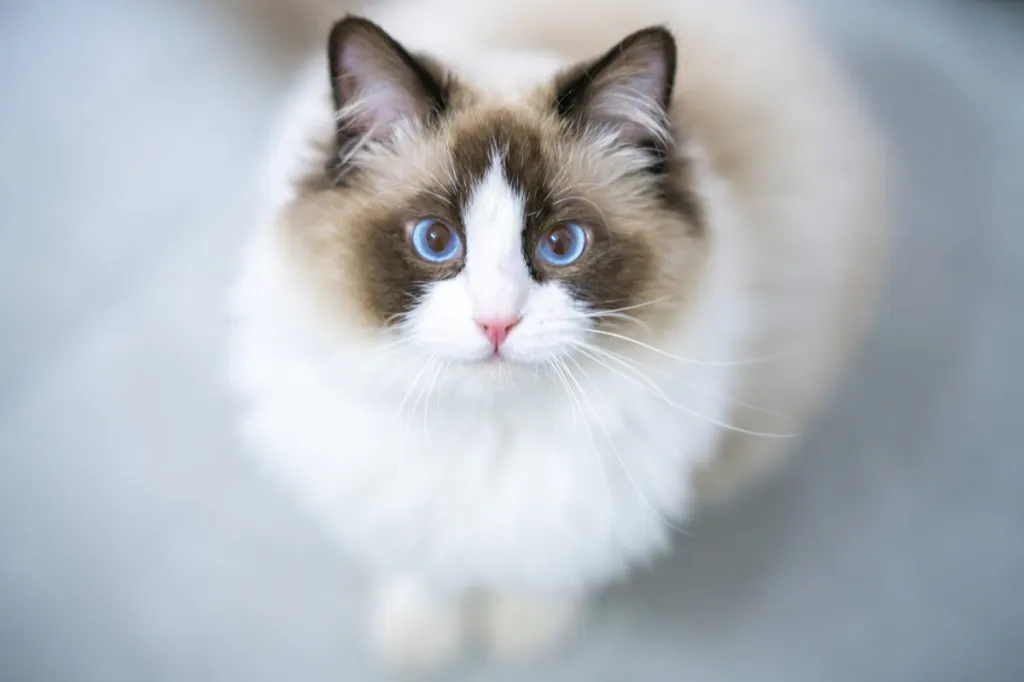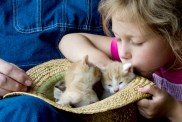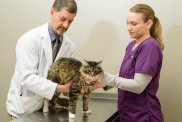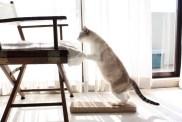The Ragdoll cat is a large-sized breed first bred in the 1960s by American breeder Ann Baker. These gentle cats are known for their elegant appearance, docile temperament, and captivating blue eyes. This breed’s somewhat controversial origins trace back to California, where they were first developed. Ragdolls are known for their large size, semi-longhair coat, and color-point patterns, with a silky texture that adds to their charm. One of their most unique traits is their tendency to go limp when picked up, a behavior that inspired their name and reflects their relaxed, gentle nature, making them ideal lap cats and companions.
Physically, Ragdolls are sturdy with mesmerizing blue almond-shaped eyes, and a color-point pattern darker on their ears, face, paws, and tail. Beyond their stunning appearance, Ragdolls are incredibly friendly and affectionate. They form deep bonds with their human families and enjoy regular interaction. Known for their social nature, Ragdolls get along well with children and other pets, earning a reputation as excellent family companions. Although their semi-longhair coats require routine grooming to prevent matting, their calm disposition makes the grooming process easier. With their captivating looks and sweet temperament, Ragdolls have become one of the most sought-after breeds, including Taylor Swift who owns an adorable Ragdoll named Benjamin Button.
Ragdoll characteristics
- Length: 17 to 21 inches (not including the tail)
- Weight: 10 to 20 pounds
- Lifespan: 12 to 17 years
Coat and color variations
Ragdoll cats are known for their semi-longhair coats, which are soft, silky, and luxurious to the touch. Their coats come in various color and pattern combinations. The breed’s fur is medium to long with a silky texture that lies flat against the body. They have a soft undercoat, which makes them less prone to matting compared to other long-haired breeds. Despite this, regular grooming is necessary to maintain their coat and keep it looking its best.
Ragdolls come in several beautiful color variations, each contributing to their distinctive look. The most common colors include:
- Seal: A rich, dark brown or almost black color, often seen on the ears, face, paws, and tail. This is one of the most popular and recognizable colors in Ragdolls.
- Blue: A soft, slate gray color with a cool undertone, lighter than seal but still striking in appearance.
- Chocolate: A warm, medium-brown color that is softer than seal.
- Lilac: A pale, frosty color with a cool tone, lighter than blue and with a subtle lavender hue.
- Red (or Flame): A soft, orange-red color, usually with a lighter tone on the body and darker points.
- Cream: A pale, off-white color with a warm undertone, similar to red but much lighter.
In addition to color, Ragdolls also exhibit different pattern variations. The most common pattern is colorpoint, where the cat’s body is lighter in color, and the extremities (ears, face, paws, and tail) are darker, with a pronounced color contrast. The mitted pattern is similar to colorpoint but includes white “mittens” on the paws and a white “bib” on the chest. The rest of the body retains the lighter color, and the points are darker. Lastly, the bicolor pattern features a more balanced distribution of color, with a white inverted “V” shape on the face, a white chest, and white paws. The body color is generally lighter, with the points being darker, though not as heavily contrasted as in the colorpoint pattern.
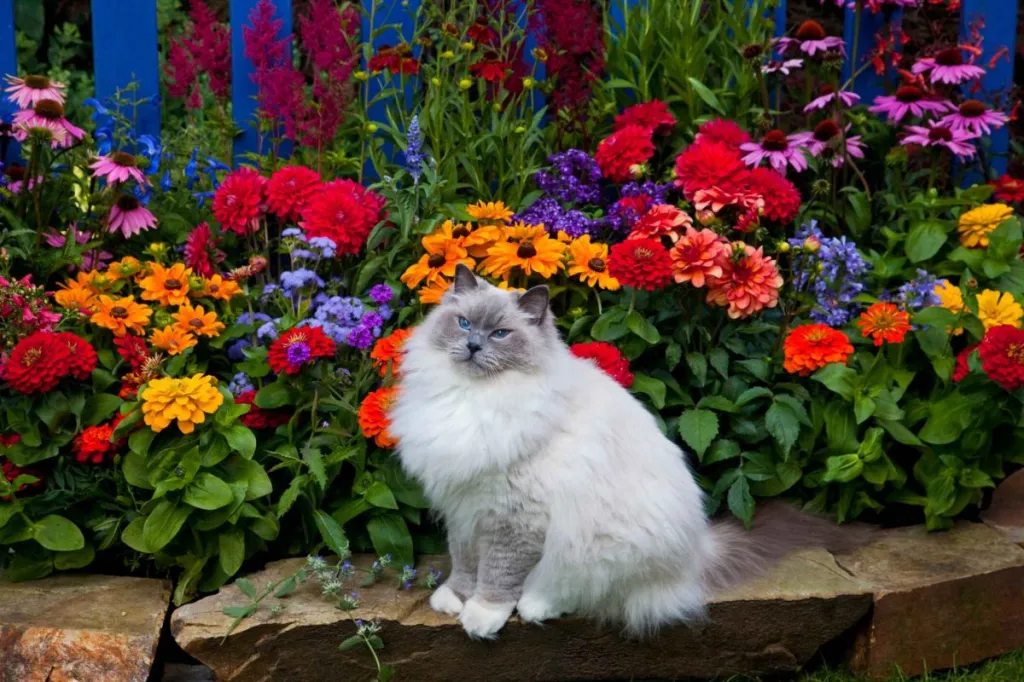
How to identify a Ragdoll cat
Ragdolls can typically be recognized by their large build, medium to long-length fur in colorpoint or mitted patterns, big blue eyes, and a tendency to come right up to you to say hello. They may sometimes be mistaken for a Persian cat, but Persian cats have a “flatter” face whereas Ragdoll cats have the more usually looking wedge-shaped feline face with an elongated appearance.
Physical traits and appearance
Size and build
- Size: Large breed, with males typically weighing 15-20 pounds and females 10-15 pounds.
- Body Build: Muscular and sturdy with a long, rectangular body, long legs, and a long fluffy tail.
Facial features
- Face Shape: Wedge-shaped face with a soft, gentle expression.
- Eyes: Striking blue, almond-shaped eyes that are a hallmark characteristic of the breed.
- Ears: Medium-sized, slightly tilted, and rounded at the tips.
Coat color and texture
- Coat: Semi-longhair coat that is silky and soft to the touch, lying flat against the body.
- Color Patterns: Color-point patterns with darker points on the ears, face, paws, and tail; common colors include seal, blue, chocolate, and lilac.
Ragdoll temperament
Ragdoll cats are known for their gentle, affectionate, and laid-back temperament. They are often described as “dog-like” because they enjoy following their owners around the house, greeting them at the door, and even playing fetch. Ragdolls form strong bonds with their human families and thrive on interaction, making them excellent companions. They are typically very social and get along well with children, other pets, and even strangers, making them an ideal choice for families or individuals looking for a friendly and affectionate feline. Ragdolls tend to be calm and easygoing, often content to be held or cuddled, and they are not known for being overly independent or aloof.
One of the most defining features of a Ragdoll’s temperament is their tendency to go limp when picked up, which is where the breed gets its name. This relaxed behavior reflects their trusting nature and makes them incredibly easy to handle. Despite their size, Ragdolls are typically not as active or hyper as some other breeds, preferring to lounge and relax in their owner’s lap. They are often described as being very tolerant and patient, even in situations where other cats might become agitated.
Personality and behavior traits
- Affectionate: Ragdolls are extremely loving and enjoy being close to their owners.
- Social: They get along well with children, other pets, and strangers.
- Gentle: Known for their calm, easygoing nature, they are rarely aggressive or temperamental.
- Dog-like: They often follow their owners around and enjoy interactive play, such as fetch.
- Laid-back: Ragdolls are content to relax and cuddle, often enjoying being held.
- Tolerant: They are patient and tolerant, making them good with children and other pets.
- Low Activity: They are not hyperactive, preferring a more laid-back lifestyle.
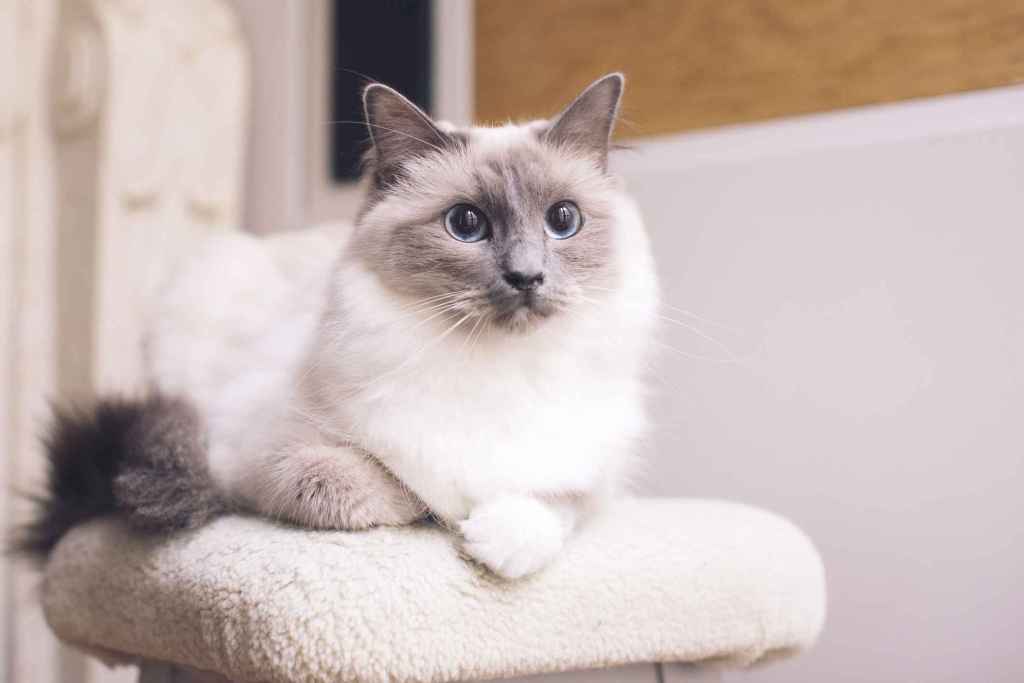
Ragdoll history
The history of the Ragdoll cat is relatively recent and somewhat controversial. The cats were first developed by breeder Ann Baker in Riverside, California, in the 1960s. Baker’s foundation stock consisted of Josephine, a domestic longhair whose white coat concealed the genes for either a seal-mitted or black tuxedo pattern, and various other longhaired cats of unknown ancestry that she owned or found in her neighborhood.
Baker selected cats with gentle, placid personalities, large sizes, and beautiful long coats characterized by a Himalayan pattern, the name for the “points” seen on Siamese-type cats. The result was a cat she called the Ragdoll, for its propensity to flop happily into the arms of anyone who picked it up. Later, Persians, Birmans, and Burmese may also have contributed to the Ragdoll’s development.
Baker made many unusual claims about the cats’ development, including alien influence, CIA experiments, and infusions of human genes, but that is all they are: claims, with no basis. Other people had begun breeding Ragdolls as well. They broke away from Baker and formed the Ragdoll Fanciers Club International, to standardize the breed and achieve recognition by cat registries.
The Cat Fanciers Association began registering the cats in 1993 and gave them full recognition in 2000. Most registries now recognize the breed, including the American Cat Fanciers Association and The International Cat Association. Ragdolls are not outcrossed to any other breeds.
Ragdoll care
Caring for a Ragdoll cat requires grooming, nutrition, veterinary, and mental care. Ragdolls are generally low-maintenance regarding their health, but they require regular grooming to maintain their coat. Their semi-longhair fur can mat if not properly cared for, so brushing them a few times a week is essential. While not as energetic as other breeds, they do love spurts of playtine. They are social and affectionate and enjoy being around their human companions. Ragdolls should be fed a balanced diet to maintain their large size, especially to help them avoid becoming overweight.
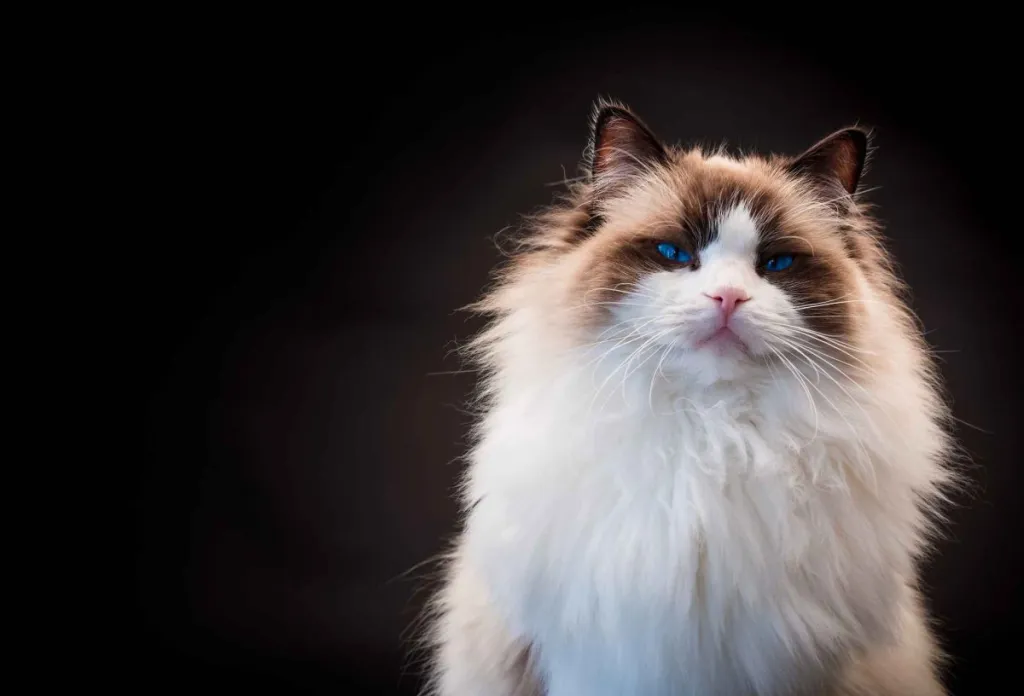
How to groom a Ragdoll
Brushing and bathing
- Brush Regularly: Use a soft-bristled brush or a comb to gently brush through the coat at least 2-3 times a week to prevent matting and tangling, especially around the neck and underarms.
- Detangle Mats: If you encounter any mats, use a de-matting comb or a special mat remover to gently work them out. Avoid pulling too hard to prevent discomfort.
- Bathing: Ragdolls don’t require frequent baths, but an occasional bath (every 4-6 months) can help keep their coat clean, especially if they are prone to getting dirty.
Nails, ears, and teeth
- Trim Nails: Trim your Ragdoll’s nails every 2-3 weeks to keep them manageable and prevent scratching damage.
- Clean Ears: Regularly check and clean their ears with a damp cotton ball or ear wipe to remove dirt and wax.
- Brush Teeth: Dental health is important, so brushing your Ragdoll’s teeth with a cat-safe toothbrush and toothpaste can help prevent dental issues.
Feeding and nutrition
Feeding a Ragdoll cat involves providing a balanced, high-quality diet tailored to their size, age, and activity level. Due to their large size and muscular build, Ragdolls may require slightly more food than smaller breeds, but overfeeding should be avoided to prevent obesity. Their diet should include high-quality protein as the primary ingredient, healthy fats, and essential vitamins and minerals. Wet food can be included to help with hydration, while dry food is beneficial for dental health. Portion control is essential to maintain their weight and overall health, and treats should only be given occasionally.
Portion sizes
- Kittens: Feed 3-4 small meals per day with kitten-specific food, following the portion recommendations on the packaging based on their weight and age.
- Adult Cats: Most adult Ragdolls need around ½ to 1 cup of dry food per day, or 3-6 ounces of wet food, depending on their activity level and metabolism. Split this into two meals per day.
- Senior Cats: Senior Ragdolls may need a lower-calorie diet to prevent weight gain. Adjust portions according to their activity level and consult your vet for specific needs.
Ragdoll cat health
Both pedigreed cats and mixed-breed cats have varying incidences of health problems that may be genetic. Problems that may affect the Ragdoll include the following:
- Hypertrophic Cardiomyopathy: A form of heart disease that is inherited in Ragdolls. A DNA-based test is available to identify cats that carry one of the mutations that causes the disease.
- Polycystic Kidney Disease (PKD): PKD is a hereditary condition that causes cysts to form on the kidneys. It can lead to kidney failure. Responsible breeders screen for PKD, and owners should ensure their cat receives regular kidney function evaluations.
- Bladder and Kidney Stones: Ragdolls may be more prone to developing urinary tract issues, including the formation of stones or crystals in the bladder and kidneys. Maintaining proper hydration and feeding a balanced diet can help reduce the risk of these issues.
- Feline Infectious Peritonitis (FIP): This is a severe and often fatal disease in cats caused by a type of coronavirus known as the feline coronavirus (FCoV). FIP is a complex and poorly understood condition that primarily affects young cats, particularly those under the age of two.
Ragdoll cats are generally known for their docile and affectionate nature, but like all breeds, they can be prone to certain health issues. Prospective owners need to be aware of these potential health concerns and provide proper care and regular veterinary check-ups.
Ragdoll kittens and rescue
When looking for a Ragdoll kitten, it’s important to find a reputable breeder who prioritizes the health and well-being of their cats. Reputable breeders will provide a clean and safe environment for their kittens, offer detailed health records, and allow you to meet the kitten’s parents. They should also be willing to answer questions about the breed and provide a contract that includes health guarantees. Be cautious of breeders who rush the sale or do not allow visits.
Alternatively, adopting a Ragdoll from a rescue organization or shelter is a wonderful way to provide a loving home to a cat in need. While the breed is popular and pricey from a breeder, many Ragdolls end up in rescues due to changes in their owners’ circumstances, and they make excellent pets regardless of age. Whether you choose to adopt or buy, the focus should be on finding a healthy, well-cared-for cat and ensuring you’re prepared to meet their needs. Here are a few resources to help you rescue a Ragdoll cat or kitten:
How much are Ragdoll kittens?
Ragdoll kittens cost between $1000 and $4500 depending on their pedigree, color, breeder reputation, and location. While it may be tempting to purchase a Ragdoll kitten at a discounted price, always do your research on the breeder to ensure they are following humane breeding practices.
